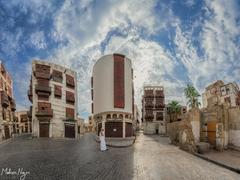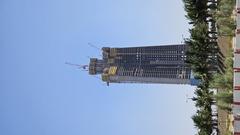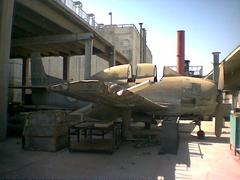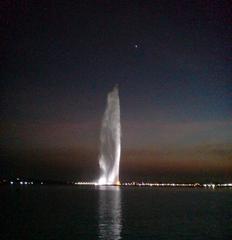
Nasseef House Visiting Hours, Tickets, and Historical Sites in Jeddah
Date: 03/07/2025
Introduction: The Significance of Nasseef House in Jeddah
Nasseef House, or Bayt Nasseef, is a cornerstone of Jeddah’s architectural and cultural heritage. Located in the UNESCO-listed Al-Balad district, this iconic residence was constructed between 1872 and 1881 by the influential Nasseef family during the late Ottoman era. The house is renowned for its traditional Hijazi architecture, featuring coral stone walls, intricate wooden latticework known as mashrabiyyas (Rawashin), and spacious interiors designed for both family life and social gatherings. Nasseef House not only reflects Jeddah’s role as a major Red Sea port and gateway for pilgrims to Mecca, but also symbolizes the city’s rich history and cosmopolitan legacy (UNESCO, Saudi Tourism Authority).
Beyond its architectural beauty, the house served as a hub for political, commercial, and social activity. A defining historical moment occurred in 1925 when King Abdulaziz Al Saud used Nasseef House as his residence upon entering Jeddah, marking the city’s integration into the modern Saudi state (Saudi Gazette). Today, Nasseef House functions as a museum and cultural center, offering exhibitions, workshops, and guided tours that celebrate the legacy of Jeddah’s historic core (Go Saudi Arabia Trips).
This guide provides everything you need to plan your visit, including up-to-date Nasseef House visiting hours, ticket details, accessibility, and highlights of the house’s architecture, exhibitions, and nearby attractions.
Contents
- Introduction
- Origins and Construction
- Role in Jeddah’s Urban and Social History
- Historical Events and Notable Residents
- Architectural Features and Innovations
- Preservation and Restoration
- Visiting Nasseef House: Practical Information
- Nearby Attractions
- FAQ
- Visitor Experience: Architectural Highlights
- Visuals and Media
- Conclusion and Call to Action
- References
Origins and Construction
Commissioned by Omar Nasseef, then governor of Jeddah, Nasseef House was built during a time when the city thrived as a commercial gateway and a hub for pilgrims. The four-story mansion, with over 40 rooms, was designed to accommodate the family’s private life and their social and commercial engagements. The house’s construction incorporated coral limestone quarried from the Red Sea coast, covered with white limestone plaster to protect against humidity. Imported teak and durable woods were used for the elaborately carved doors, ceilings, and the distinctive Rawashin (Saudipedia).
Role in Urban and Social History
Strategically located on Suq Al-Alawi, one of Al-Balad’s main commercial streets, Nasseef House was central to Jeddah’s merchant and political life. The Nasseef family’s stature made the residence a focal point for diplomatic receptions, trade negotiations, and community gatherings (Arab News). Its grand halls, rooftop terrace, and wide staircase—designed to allow camels to access upper floors—reflect the practical and social needs of the period.
Historical Events and Notable Residents
Nasseef House is closely associated with key moments in Saudi history. Most notably, King Abdulaziz Al Saud stayed in the house during Jeddah’s transition into the modern Kingdom in 1925. The Nasseef family remained residents until the 1970s, witnessing the evolution of Jeddah from a traditional port city to a modern urban center (Saudi Gazette).
Architectural Features and Innovations
Nasseef House is a masterclass in Hijazi architecture and climate adaptation. Thick coral stone walls insulate against heat, while Rawashin provide ventilation and privacy. The gently sloping staircase, designed for camel-mounted messengers, and the rooftop “mastaba” for enjoying sea breezes are unique features. Interiors showcase decorative plasterwork, painted wooden beams, and stained glass, all illustrating the craftsmanship of the era (Saudi Tourism Authority).
Preservation and Restoration
By the late 20th century, Nasseef House required significant restoration. Renovations in the 1980s and 1990s preserved its original features and adapted it as a museum and cultural center. Since reopening to the public in 2009, the house has hosted exhibitions, lectures, and events, playing a key role in the revitalization of Al-Balad—designated a UNESCO World Heritage Site in 2014 (UNESCO).
Visiting Nasseef House: Practical Information
Location and Accessibility
Nasseef House is located on Suq Al-Alawi in Al-Balad, Jeddah’s historic heart (Lonely Planet). The site is easily reached by taxi or ride-hailing services; parking is limited, so walking or public transport is recommended. The museum provides ramps and assistance for visitors with mobility challenges, and signage is available in multiple languages.
Visiting Hours
- General Opening: Saturday to Thursday, 9:00 AM – 5:00 PM (Go Saudi Arabia Trips)
- Extended Hours: Some sources report hours from 8:00 AM – 11:55 PM, especially during special events (Safarway).
- Closed: Fridays and public holidays.
- Recommendation: Always check ahead for the latest updates.
Tickets and Booking
- Admission: Free for general visits; some special exhibitions or guided tours may have a modest fee (Go Saudi Arabia Trips).
- Guided Tours: Available in Arabic and English; book through the official tourism portal or at the entrance.
Facilities and Amenities
- Basic restrooms on site.
- No café inside, but Al-Balad offers many nearby dining options.
- Limited accessibility for upper floors due to historic architecture.
Dress Code and Etiquette
Modest dress is required; both men and women should cover shoulders and knees. Shoes may need to be removed in certain areas. Photography is allowed, but flash and touching delicate exhibits are discouraged.
Nearby Attractions
- Souq Al-Alawi: Jeddah’s largest traditional market, perfect for shopping and cultural immersion.
- Matbouli House Museum: Another exemplary Hejazi residence.
- Al Shafee Mosque: A historic mosque with beautiful architecture.
- Bab Makkah: The historic gate marking the pilgrimage route to Mecca.
A visit to Nasseef House is easily combined with these sites for a comprehensive experience of Al-Balad’s heritage.
FAQ
Q: What are the visiting hours of Nasseef House?
A: Typically open Saturday to Thursday, 9:00 AM – 5:00 PM; extended hours possible during events.
Q: How much are tickets?
A: Admission is generally free; special tours or exhibitions may have a nominal fee.
Q: Is Nasseef House wheelchair accessible?
A: Main exhibition areas are accessible, but some upper floors are not due to the historic structure.
Q: Are guided tours available?
A: Yes, in Arabic and English. Booking ahead is recommended.
Q: Can I take photos inside?
A: Yes, but avoid flash and always confirm with staff.
Q: What’s the best time to visit?
A: October to April offers cooler weather and comfortable walking conditions.
Visitor Experience: Architectural Highlights
- Admire the elaborate Rawashin from the street and interior rooms.
- Explore the unique staircase and rooftop mastaba.
- Visit the shaded courtyard and see Jeddah’s oldest neem tree at the entrance.
- Discover rare manuscripts, period furnishings, and historical artifacts in the museum exhibits.
Visuals and Media Suggestions
- Exterior view of Nasseef House (alt: “Nasseef House historic building Al-Balad Jeddah”)
- Interior showcasing mashrabiya windows (alt: “Mashrabiya windows inside Nasseef House Jeddah”)
- Map of Al-Balad with Nasseef House location (alt: “Map of Al-Balad with Nasseef House location”)
- Cultural event or workshop inside the museum (alt: “Cultural workshop at Nasseef House museum Jeddah”)
Conclusion and Call to Action
Nasseef House is not just an architectural gem—it is a living museum that connects visitors to Jeddah’s vibrant history and evolving cultural identity. Its preservation and continued use as a cultural center make it an essential destination for anyone interested in Saudi heritage. Plan your visit to Nasseef House, explore the surrounding treasures of Al-Balad, and immerse yourself in the unique blend of history, architecture, and community.
References
- Nasseef House, UNESCO World Heritage Centre (UNESCO)
- Nasseef House, Saudi Tourism Authority (Saudi Tourism Authority)
- King Abdulaziz’s Residence at Nasseef House, Saudi Gazette (Saudi Gazette)
- Nasseef House Historical Overview, Saudipedia (Saudipedia)
- Cultural Significance and Visitor Information, Go Saudi Arabia Trips (Go Saudi Arabia Trips)
- History of Nasseef House, Darul Quran Al Saeedia (Darul Quran Al Saeedia)
- Nasseef House Visitor Guide, Lonely Planet (Lonely Planet)
- Additional insights from Travelspilot, Safarway, GetYourGuide, Rehlat, Wasalt Blog, Travel Tomorrow, and HelloTravel.







